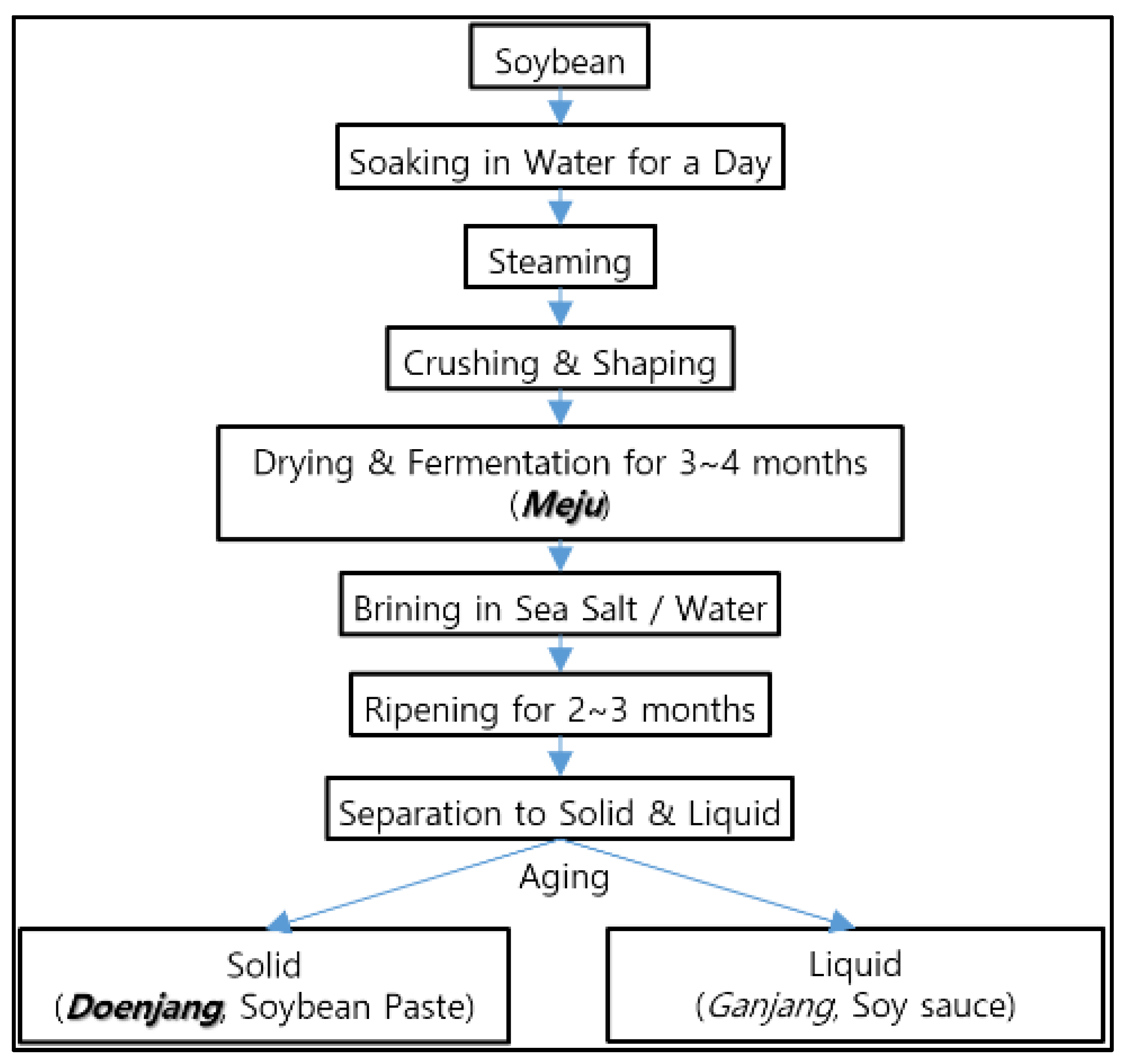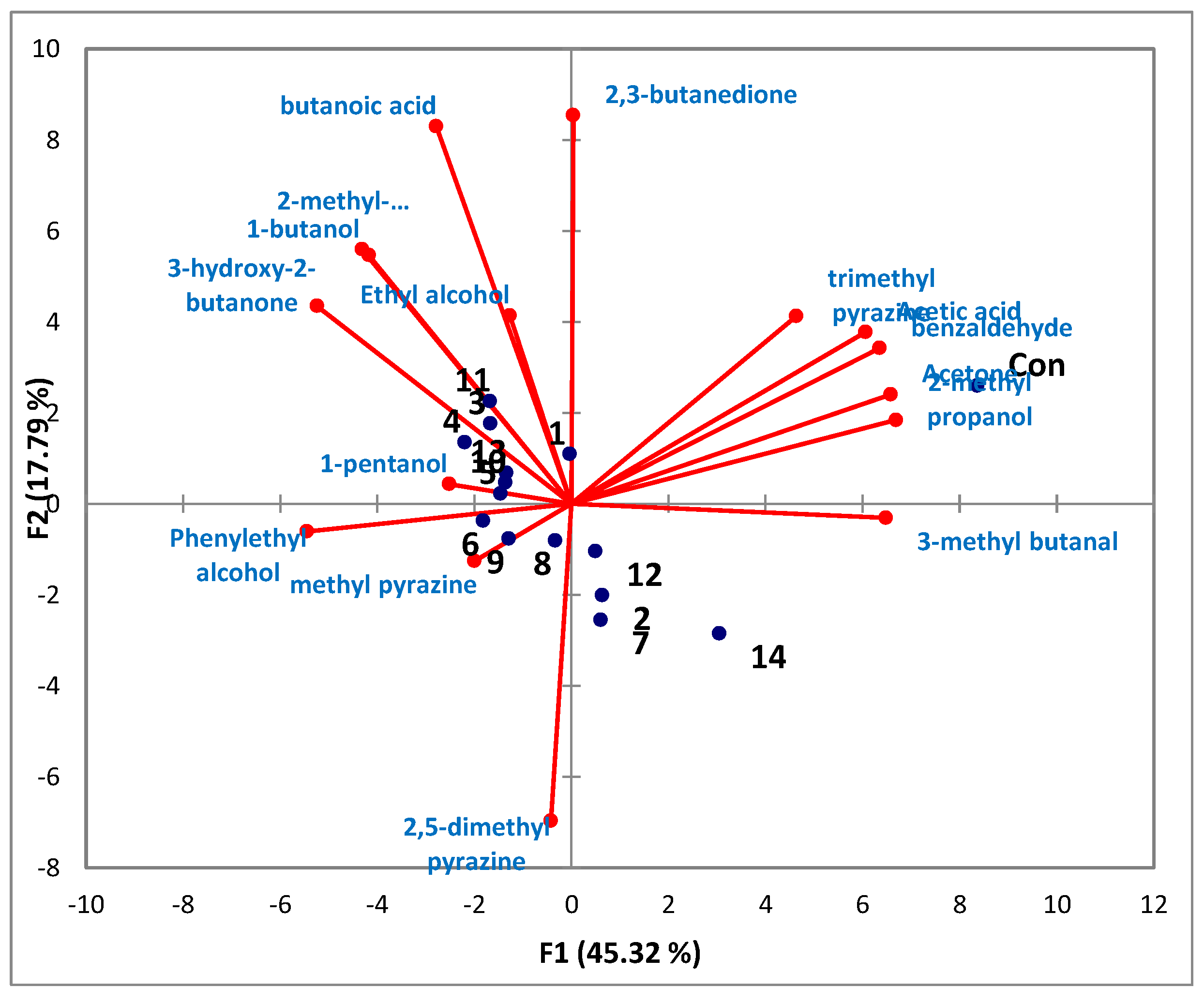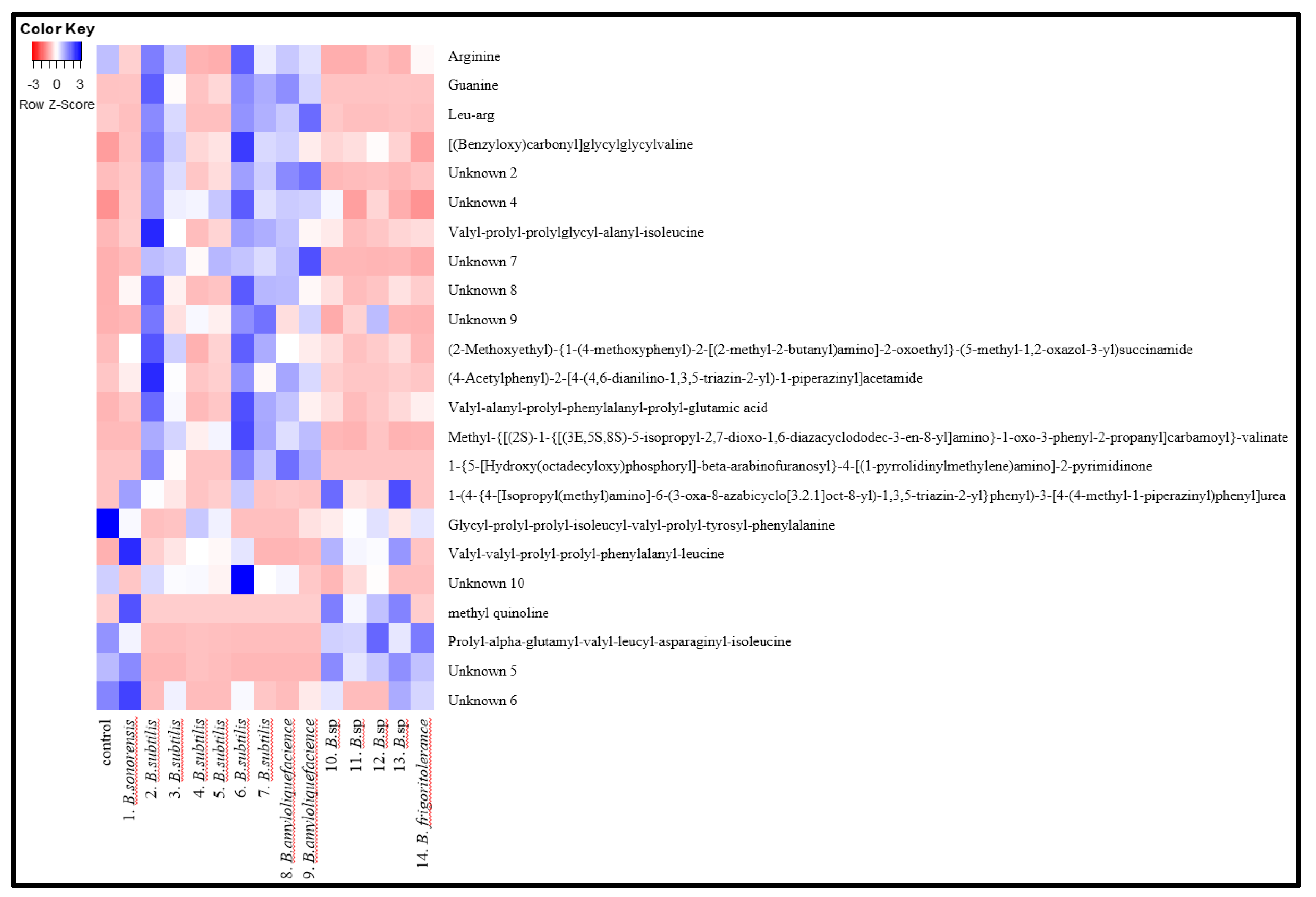Characteristics of Bacterial Strains with Desirable Flavor Compounds from Korean Traditional Fermented Soybean Paste (Doenjang)
Abstract
1. Introduction
2. Results
2.1. Screening of Strains
2.2. Enzyme Activity of Microorganisms from Doenjang
2.3. Descriptive and Volatile Analysis of Cultures
2.4. Non-Volatile Analysis of Culture
3. Discussion
4. Materials and Methods
4.1. Doenjang Products for Strain Screening
4.2. Media and Screening
4.3. Identification of Isolated Strains
4.4. Protease Assay
4.5. Amylase Assay
4.6. Lipase Assay
4.7. Descriptive Analysis and Sensory Evaluation
4.8. Extraction of Volatiles by the Headspace Solid-Phase Microextraction (HS-SPME)
4.9. Analysis of Volatiles by GC/MS
4.10. The Ultra-High Performance Liquid Chromatography-Quadrupole Time-of-Flight Mass Spectrometry (UPLC-Q TOF-MS) Analysis
4.11. Statistical Analysis
5. Conclusions
Author Contributions
Funding
Institutional Review Board Statement
Informed Consent Statement
Data Availability Statement
Conflicts of Interest
Sample Availability
References
- Hong, S.P. Strategy for the globalization of Korean traditional fermented soybean food as a global fermented products. Food Preserv. Process. Ind. 2015, 14, 31–36. [Google Scholar]
- Park, H.K.; Gil, B.; Kim, J.K. Characteristics of taste components of commercial soybean paste. Food Sci. Biotechnol. 2002, 11, 376–379. [Google Scholar]
- Hong, S.-B.; Kim, D.-H.; Lee, M.; Baek, S.-Y.; Kwon, S.-W.; Samson, R.A. Taxonomy of Eurotium species isolated from meju. J. Microbiol. 2011, 49, 669–674. [Google Scholar] [CrossRef]
- Hong, S.-B.; Kim, D.-H.; Lee, M.; Baek, S.-Y.; Kwon, S.-W.; Houbraken, J.; Samson, R.A. Zygomycota associated with traditional meju, a fermented soybean starting material for soy sauce and soybean paste. J. Microbiol. 2012, 50, 386–393. [Google Scholar] [CrossRef] [PubMed]
- Kim, Y.-S.; Kim, M.-C.; Kwon, S.-W.; Kim, S.-J.; Park, I.-C.; Ka, J.-O.; Weon, H.-Y. Analyses of bacterial communities in meju, a Korean traditional fermented soybean bricks, by cultivation-based and pyrosequencing methods. J. Microbiol. 2011, 49, 340–348. [Google Scholar] [CrossRef] [PubMed]
- Lee, S.S. Meju fermentation for a raw material of Korean traditional soy products. Korean J. Mycol. 1995, 23, 161–175. [Google Scholar]
- Kim, S.H.; Lee, K.A. Evaluation of taste compounds in water soluble extract of Doenjang (soybean paste). Food Chem. 2003, 83, 339–342. [Google Scholar] [CrossRef]
- Choi, K.S.; Choi, J.D.; Chung, H.C.; Kwon, K.I.; Im, M.H.; Kim, Y.H.; Kim, W.S. Effects of mashing proportion of soybean to salt brine on Kanjang (soy sauce) quality. Korean J. Food Sci. Technol. 2000, 32, 174–180. [Google Scholar] [CrossRef]
- Yang, S.H.; Choi, M.R.; Kim, J.K.; Chung, Y.G. Optimization of the taste components composition in traditional Korean soybean paste. J. Korean Soc. Food Sci. Nutr. 1992, 21, 449–453. [Google Scholar]
- Oh, S.J.; Lim, J.H.; Lim, S.B. Quality characteristics of Jeju traditional Doenjang. Korean J. Culin. Res. 2009, 15, 298–308. [Google Scholar]
- Seo, J.H.; Jeoung, Y.J. Quality characteristics of Doenjang using squid internal organs. Korean J. Food Sci. Biotechnol. 2001, 33, 89–93. [Google Scholar]
- Shin, Z.-I.; Yu, R.; Park, S.-A.; Chung, D.K.; Ahn, C.-W.; Nam, H.-S.; Kim, K.-S.; Lee, H.J. His-His-Leu, an angiotensin I converting enzyme inhibitory peptide derived from Korean soybean paste, exerts antihypertensive activity in vivo. J. Agric. Food Chem. 2001, 49, 3004–3009. [Google Scholar] [CrossRef] [PubMed]
- Kim, D.H.; Song, H.P.; Kim, K.Y.; Kim, J.O.; Byun, M.W. A correlation between fibrinolytic activity and microflora in Korean fermented soybean products. J. Korean Soc. Food Sci. Nutr. 2004, 33, 41–46. [Google Scholar]
- Lee, C.H.; Moon, S.Y.; Lee, J.C.; Lee, J.Y. Study on the antioxidant activity of soybean products extracts for application of animal products. Korean J. Food Sci. Anim. Resour. 2004, 24, 405–410. [Google Scholar]
- Jung, K.O.; Park, S.Y.; Park, K.Y. Longer aging time increases the anticancer and antimetastic properties of Doenjang. Nutrition 2006, 22, 539–545. [Google Scholar] [CrossRef] [PubMed]
- Park, K.Y.; Jung, K.O.; Rhee, S.H.; Choi, Y.H. Antimetagenic effects of Doenjang (Korean fermented soy paste) and its active compounds. Mutat. Res. 2003, 523–524, 43–53. [Google Scholar] [CrossRef]
- Chung, L.; Chung, S. Cross-Cultural Comparisons among the Sensory Characteristics of Fermented Soybean Using Korean and Japanese Descriptive Analysis Panels. J. Food Sci. 2007, 72, S676–S688. [Google Scholar] [CrossRef]
- Lee, S.; Ahn, B. Comparison of volatile components in fermented soybean pastes using simultaneous distillation and extraction (SDE) with sensory characterization. Food Chem. 2009, 114, 600–609. [Google Scholar] [CrossRef]
- Kim, H.; Hong, J.; Song, C.; Shin, H.; Kim, K. Sensory Characteristics and Consumer Acceptability of Fermented Soybean Paste (Doenjang). J. Food Sci. 2010, 75, S375–S383. [Google Scholar] [CrossRef]
- Shin, M.R.; Joo, K.J. Fractionated volatile flavor components of soybean paste by dynamic headspace method. J. Korean Soc. Food Sci. Nutr. 1999, 28, 305–311. [Google Scholar]
- Lee, J.-E.; Kang, S.H.; Kim, H.R.; Lim, S.I. Volatile Compounds Analysis of Certified Traditional Doenjang. J. Korean Soc. Food Sci. Nutr. 2015, 44, 944–950. [Google Scholar] [CrossRef]
- Kim, J.H.; Yoo, J.S.; Lee, C.H.; Kim, S.Y.; Lee, S.K. Quality properties of soybean pastes made from Meju with mold producing protease isolated from traditional Meju. J. Korean Soc. Appl. Biol. Chemi. 2006, 49, 7–14. [Google Scholar]
- Park, S.K.; Seo, K.I.; Choi, S.H.; Moon, J.S.; Lee, Y.H. Quality assessment of commercial Doenjang prepared by traditional method. J. Korean Soc. Food Sci. Nutr. 2000, 29, 211–217. [Google Scholar]
- Jo, Y.-J.; Cho, I.H.; Song, C.K.; Shin, H.W.; Kim, Y.-S. Comparison of Fermented Soybean Paste (Doenjang) Prepared by Different Methods Based on Profiling of Volatile Compounds. J. Food Sci. 2011, 76, C368–C379. [Google Scholar] [CrossRef] [PubMed]
- Ku, M.S. Fundamental study for recognition of long term aged Doenjang. KFRI Rep. 2009, 1, 92–124. Available online: https://scienceon.kisti.re.kr/commons/util/originalView.do?cn=TRKO201000000504&dbt=TRKO&rn=&keyword=%EB%90%9C%EC%9E%A5%20 (accessed on 15 March 2021).
- Ku, K.-H.; Park, K.; Kim, H.J.; Kim, Y.; Koo, M. Quality Characteristics of Doenjang by Aging Period. J. Korean Soc. Food Sci. Nutr. 2014, 43, 720–728. [Google Scholar] [CrossRef]
- Jeon, H.; Lee, S.; Kim, S.; Kim, Y. Quality Characteristics of Modified Doenjang and Traditional Doenjang. J. Korean Soc. Food Sci. Nutr. 2016, 45, 1001–1009. [Google Scholar] [CrossRef][Green Version]
- Ryu, D.Y.; Surh, J.H. Quality characteristics and oxidative stability of Gangwon traditional Doenjang fermented for different time. J. Korean Soc. Food Sci. Nutr. 2021, 50, 69–78. [Google Scholar] [CrossRef]
- Yoo, J.Y.; Kim, H.G. Characteristics of traditional Mejus of nation-wide collection. J. Korean Soc. Food Sci. Nutr. 1998, 27, 259–267. [Google Scholar]
- Baek, H.H. Compilation of volatiles flavor compounds in Cheonggukjang and Doenjang. Food Sci. Ind. 2017, 12, 24–49. [Google Scholar]
- Xio, Z.; Xu, P. Acetoin metabolism in bacteria. CRC Rev. Microbiol. 2007, 33, 127–140. [Google Scholar] [CrossRef] [PubMed]
- Kaneko, S.; Kumazawa, K.; Nishimura, O. Comparison of Key Aroma Compounds in Five Different Types of Japanese Soy Sauces by Aroma Extract Dilution Analysis (AEDA). J. Agric. Food Chem. 2012, 60, 3831–3836. [Google Scholar] [CrossRef] [PubMed]
- Shuo, W.; Takehiro, T.; Nobuyuki, K.; Xiaofang, L.; Han, J.; Yoshinobu, A.; Jie, Y.C. Effect of volatile compounds on the quality on the Japanese fermented soy sauce. LWT Food Sci. Technol. 2019, 111, 594–601. [Google Scholar]
- Chakravorty, S.; Helb, D.; Burday, M.; Connell, N.; Alland, D. A detailed analysis of 16S ribosomal RNA gene segments for the diagnosis of pathogenic bacteria. J. Microbiol. Methods 2007, 69, 330–339. [Google Scholar] [CrossRef]
- Zhang, Z.; Schwartz, S.; Wagner, L.; Miller, W. A Greedy Algorithm for Aligning DNA Sequences. J. Comput. Biol. 2000, 7, 203–214. [Google Scholar] [CrossRef] [PubMed]
- Thomson, J.D.; Higgins, D.G.; Gibson, T.J.; Clustal, W. Improving the sensitivity of progressive multiple sequence alignment through sequence weighting, position-specific gap penalties and weight matrix choice. Nucleic Acids Res. 1994, 22, 4673–4680. [Google Scholar] [CrossRef]
- Lee, S.Y.; Eom, J.S.; Choi, H.S. Quality Characteristics of Fermented Soybean Products by Bacillus sp. Isolated from Traditional Soybean Paste. J. Korean Soc. Food Sci. Nutr. 2014, 43, 756–762. [Google Scholar] [CrossRef]
- Kim, S.Y.; Park, Y.J.; Lee, C.Y. Factors that influence the activity of a Candida lipase. J. Korean Agric. Chem. Biotechnol. 1971, 14, 207–212. [Google Scholar]




| Strains | Enzymes (Units) | ||
|---|---|---|---|
| Lipase | Amylase | Protease | |
| B. sonorensis | 982.2 ± 19.9 b | 0 a | 221.4 ± 5.1 a,b |
| B. subtilis-H1 | 1090.9 ± 20.3 d | 171.8 ± 7.0 b | 272.6 ± 5.1 d,e |
| B. subtilis-H2 | 1047.6 ± 50.1 c,d | 0 a | 276.6 ± 14.3 d,e,f |
| B. subtilis-H3 | 988.6 ± 32.1 b,c | 0 a | 285.0 ± 6.7 e,f |
| B. subtilis-H4 | 1015.6 ± 30.8 b,c | 0 a | 241.8 ± 12.2 c |
| B. subtilis-H5 | 1023.6 ± 13.8 b,c | 0 a | 255.8 ± 6.8 c,d |
| B. subtilis-H6 | 1355.2 ± 50.6 f | 4105.5 ± 105.4 f | 292.6 ± 7.5 e,f,g |
| B. amyloliquefacience-J1 | 1251.8 ± 8.6 e | 0 a | 279.1 ± 2.9 d,e,f |
| B. amyloliquefacience-J2 | 1310.3 ± 19.8 f | 242.6 ± 8.4 c | 319.5 ± 2.9 h |
| B. sp-K1 | 2453.6 ± 51.2 i | 0 a | 206.0 ± 8.8 a |
| B. sp-K2 | 1639.9 ± 39.8 h | 0 a | 300.9 ± 13.7 f,g,h |
| B. sp-K3 | 1558.7 ± 12.2 g | 860.0 ± 20.9 d | 317.1 ± 8.2 g,h |
| B. sp-K4 | 1588.9 ± 9.8 g,h | 271.0 ± 9.4 c | 317.3 ± 44.1 g,h |
| B. frigoritolerance | 924.9 ± 41.6 a | 0 a | 221.2 ± 4.5 a,b |
| Compounds (Odor) | Control | B. sonorensis | B.subtilis-H2 | B.subtilis-H3 | B.subtilis-H4 | B.subtilis-H5 | B.subtilis-H6 | B.subtilis-H7 | B.amyloliquefaciens-J2 | B.amyloliquenfaciens-J3 | B.sp-K2 | B.sp-K3 | B.sp-K4 | B.sp-K5 | B. frigoritolerance |
|---|---|---|---|---|---|---|---|---|---|---|---|---|---|---|---|
| Ethyl alcohol | 0.14 | 3.17 | 0.00 | 0.00 | 0.00 | 0.00 | 0.00 | 0.00 | 0.00 | 0.00 | 2.47 | 1.88 | 0.66 | 2.15 | 0.02 |
| Acetone | 17.23 | 7.71 | 10.27 | 4.47 | 4.89 | 5.36 | 5.24 | 9.12 | 8.15 | 5.83 | 4.94 | 5.60 | 8.67 | 4.84 | 9.92 |
| 2-Methyl propanol | 5.07 | 1.52 | 1.30 | 0.35 | 0.47 | 0.48 | 0.56 | 2.37 | 1.00 | 0.50 | 0.90 | 0.94 | 1.75 | 0.83 | 2.99 |
| 2,3-Butanedione (Buttery, cheese) | 7.44 | 8.65 | 9.70 | 8.69 | 8.93 | 8.43 | 7.71 | 9.41 | 10.03 | 8.45 | 7.70 | 9.18 | 7.16 | 7.62 | 7.20 |
| 3-Methyl butanal (Malty) | 26.39 | 14.79 | 16.31 | 6.96 | 6.09 | 8.41 | 8.03 | 15.90 | 13.77 | 8.50 | 11.94 | 12.62 | 21.19 | 10.92 | 32.00 |
| Acetic acid (Sour) | 11.27 | 9.06 | 6.82 | 5.50 | 5.16 | 5.80 | 5.43 | 6.60 | 6.02 | 4.63 | 6.41 | 6.85 | 9.27 | 6.01 | 10.62 |
| 1-Butanol (Soap, Fatty, diesel) | 0.94 | 15.44 | 2.23 | 8.79 | 11.42 | 11.01 | 11.43 | 2.15 | 3.41 | 6.99 | 12.59 | 13.93 | 15.53 | 11.63 | 1.43 |
| 3-Hydroxy-2-butanone (Acetoin, Buttery) | 1.62 | 14.91 | 23.51 | 43.37 | 41.01 | 33.69 | 35.05 | 17.63 | 30.04 | 37.53 | 25.47 | 35.23 | 3.63 | 30.50 | 2.27 |
| 1-Pentanol | 0.42 | 1.61 | 0.98 | 0.99 | 1.03 | 0.65 | 1.27 | 1.16 | 1.49 | 0.82 | 0.75 | 0.78 | 1.04 | 0.71 | 0.85 |
| 2-Methyl-propanoic acid | 0.41 | 0.65 | 0.59 | 1.24 | 1.06 | 1.21 | 0.71 | 0.98 | 0.76 | 0.88 | 1.09 | 1.30 | 0.99 | 1.09 | 0.70 |
| Methyl pyrazine (Nutty, roasted) | 2.60 | 3.48 | 4.19 | 2.98 | 3.18 | 3.66 | 3.60 | 4.72 | 3.89 | 3.85 | 3.62 | 3.78 | 3.93 | 3.41 | 4.02 |
| Butanoic acid (Sour) | 0.45 | 0.88 | 0.51 | 0.54 | 0.69 | 0.75 | 0.74 | 0.25 | 0.59 | 0.61 | 0.68 | 0.72 | 0.67 | 0.68 | 0.18 |
| 2,5-Dimethyl pyrazine (Nutty, roasted) | 8.16 | 14.26 | 18.59 | 11.81 | 12.61 | 16.29 | 15.77 | 22.58 | 16.51 | 16.73 | 16.64 | 2.16 | 18.62 | 15.27 | 19.21 |
| Benzaldehyde (Sweet, candy, wood) | 15.45 | 1.83 | 2.11 | 1.82 | 1.32 | 1.70 | 1.78 | 3.61 | 1.73 | 1.86 | 2.08 | 2.15 | 4.06 | 1.88 | 5.94 |
| Trimethyl pyrazine (Nutty, roasted) | 2.40 | 1.91 | 2.46 | 2.13 | 1.77 | 2.19 | 2.15 | 3.01 | 2.22 | 2.36 | 2.25 | 2.26 | 2.37 | 2.09 | 2.40 |
| Phenylethyl alcohol (Rose) | 0.02 | 0.12 | 0.43 | 0.36 | 0.37 | 0.39 | 0.55 | 0.52 | 0.37 | 0.47 | 0.48 | 0.63 | 0.47 | 0.39 | 0.26 |
| Total | 100.00 | 100.00 | 100.00 | 100.00 | 100.00 | 100.00 | 100.00 | 100.00 | 100.00 | 100.00 | 100.00 | 100.00 | 100.00 | 100.00 | 100.00 |
| No. | RT (min) | Compound | Exact Mass | MS Fragments | VIP | p-Value |
|---|---|---|---|---|---|---|
| (M + H) | ||||||
| 1 | 0.69 | Arginine | 175.1190 | 1.26 | 1.66 × 10−4 | |
| 2 | 1.01 | Guanine | 152.0572 | 135 | 1.56 | 2.82 × 10−5 |
| 3 | 1.43 | Leu-arg | 288.2019 | 158 | 1.47 | 1.82 × 10−5 |
| 4 | 1.70 | Adenine | 136.0762 | 1.20 | 5.73 × 10−2 | |
| 5 | 2.61 | Unknown 1 | 343.1979 | 0.99 | 1.43 × 10−1 | |
| 6 | 2.89 | [(Benzyloxy)carbonyl]glycylglycylvaline | 366.1685 | 203, 130 | 1.25 | 2.49 × 10−2 |
| 7 | 3.02 | Unknown 2 | 515.2479 | 1.44 | 2.38 × 10−4 | |
| 8 | 3.05 | Unknown 3 | 344.1820 | 1.19 | 7.59 × 10−2 | |
| 9 | 3.12 | Unknown 4 | 442.2668 | 1.29 | 2.46 × 10−3 | |
| 10 | 3.51 | Methyl quinoline | 144.0820 | 1.53 | 5.28 × 10−5 | |
| 11 | 3.60 | Unknown 5 | 508.2507 | 1.53 | 4.56 × 10−6 | |
| 12 | 3.81 | Unknown 6 | 288.1925 | 1.18 | 8.14 × 10−7 | |
| 13 | 4.00 | Valyl-prolyl-prolylglycyl-alanyl-isoleucine | 553.3373 | 147, 244 | 1.34 | 2.05 × 10−3 |
| 14 | 4.02 | Unknown 7 | 585.3271 | 1.25 | 1.41 × 10−4 | |
| 15 | 4.23 | Unknown 8 | 560.2731 | 1.50 | 1.67 × 10−4 | |
| 16 | 4.27 | Unknown 9 | 360.1964 | 1.03 | 1.10 × 10−2 | |
| 17 | 4.43 | (2-Methoxyethyl)-{1-(4-methoxyphenyl)-2-[(2-methyl-2-butanyl)amino]-2-oxoethyl}-(5-methyl-1,2-oxazol-3-yl)succinamide | 489.2714 | 374, 279 | 1.39 | 1.17 × 10−3 |
| 18 | 4.71 | Prolyl-alpha-glutamyl-valyl-leucyl-asparaginyl-isoleucine | 684.3945 | 427, 555 | 1.28 | 1.60 × 10−10 |
| 19 | 5.04 | (4-Acetylphenyl)-2-[4-(4,6-dianilino-1,3,5-triazin-2-yl)-1-piperazinyl]acetamide | 523.2538 | 360 | 1.40 | 4.76 × 10−4 |
| 20 | 5.16 | Valyl-alanyl-prolyl-phenylalanyl-prolyl-glutamic acid | 659.3424 | 70, 227 | 1.57 | 7.73 × 10−7 |
| 21 | 5.21 | Methyl-{[(2S)-1-{[(3E,5S,8S)-5-isopropyl-2,7-dioxo-1,6-diazacyclododec-3-en-8-yl]amino}-1-oxo-3-phenyl-2-propanyl]carbamoyl}-valinate | 558.3306 | 263, 360 | 1.42 | 5.27 × 10−4 |
| 22 | 5.69 | 1-{5-[Hydroxy(octadecyloxy)phosphoryl]-beta-arabinofuranosyl}-4-[(1-pyrrolidinylmethylene)amino]-2-pyrimidinone | 657.4005 | 583 | 1.59 | 2.67 × 10−7 |
| 23 | 5.82 | 1-(4-{4-[Isopropyl(methyl)amino]-6-(3-oxa-8-azabicyclo [3.2.1]oct-8-yl)-1,3,5-triazin-2-yl}phenyl)-3-[4-(4-methyl-1-piperazinyl)phenyl]urea | 572.3463 | 554 | 1.44 | 8.01 × 10−4 |
| 24 | 6.08 | Glycyl-prolyl-prolyl-isoleucyl-valyl-prolyl-tyrosyl-phenylalanine | 889.4830 | 507, 627 | 1.13 | 7.75 × 10−10 |
| 25 | 6.09 | Valyl-valyl-prolyl-prolyl-phenylalanyl-leucine | 671.4117 | 217, 376, 473 | 1.57 | 2.19 × 10−5 |
| 26 | 6.76 | Unknown 10 | 274.2727 | 1.07 | 3.68 × 10−8 |
Publisher’s Note: MDPI stays neutral with regard to jurisdictional claims in published maps and institutional affiliations. |
© 2021 by the authors. Licensee MDPI, Basel, Switzerland. This article is an open access article distributed under the terms and conditions of the Creative Commons Attribution (CC BY) license (https://creativecommons.org/licenses/by/4.0/).
Share and Cite
Yi, S.-H.; Hong, S.-P. Characteristics of Bacterial Strains with Desirable Flavor Compounds from Korean Traditional Fermented Soybean Paste (Doenjang). Molecules 2021, 26, 5067. https://doi.org/10.3390/molecules26165067
Yi S-H, Hong S-P. Characteristics of Bacterial Strains with Desirable Flavor Compounds from Korean Traditional Fermented Soybean Paste (Doenjang). Molecules. 2021; 26(16):5067. https://doi.org/10.3390/molecules26165067
Chicago/Turabian StyleYi, Sung-Hun, and Sang-Pil Hong. 2021. "Characteristics of Bacterial Strains with Desirable Flavor Compounds from Korean Traditional Fermented Soybean Paste (Doenjang)" Molecules 26, no. 16: 5067. https://doi.org/10.3390/molecules26165067
APA StyleYi, S.-H., & Hong, S.-P. (2021). Characteristics of Bacterial Strains with Desirable Flavor Compounds from Korean Traditional Fermented Soybean Paste (Doenjang). Molecules, 26(16), 5067. https://doi.org/10.3390/molecules26165067





